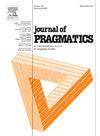Uso“谎言”还是hontoo“真相”?日语信息中的两个词汇响应标记
IF 1.8
1区 文学
0 LANGUAGE & LINGUISTICS
引用次数: 0
摘要
本会话分析研究考察了日语通知序列中的两个应答符号“uso”和“hontoo”。尽管它们经常用于通知序列,但很少有实证研究对这两个标记的相互作用特性进行了研究。为了探索uso和hontoo之间的异同,本研究调查了他们在两种类型的信息中的工作方式:用最少数量的回合结构单位完成的信息,以及需要大量扩展的回合-谈话的信息。在此过程中,本研究揭示了uso和hontoo如何在不同的顺序位置充当新闻收据和新闻标记,以及它们如何在随后的回合中导致不同的动作轨迹。通过描述uso和hontoo的交互特征,本研究旨在提供关于特定令牌如何以语言敏感的方式响应信息的观点,同时也以类似于其他语言中的特定令牌的方式。本文章由计算机程序翻译,如有差异,请以英文原文为准。
Uso “lie” or hontoo “truth”?: Two lexical response tokens in Japanese informings
This conversation analytic study examines two response tokens uso and hontoo in Japanese informing sequences. Despite their frequent use in informing sequences, little empirical research has been done on the interactional properties of the two tokens. To explore similarities and differences between uso and hontoo, this study investigates their workings in two types of informings: informings done with a minimal number of turn-constructional units, and informings that require a largely extended turn-at-talk. In so doing, the present research reveals how uso and hontoo serve as news receipts and newsmarks at different sequential locations and how they lead to different action trajectories in the subsequent turns. By delineating the interactional features of uso and hontoo, this study aims to provide perspectives on how particular tokens act as responses to informings in a language-sensitive manner and yet also in ways similar to specific tokens in other languages.
求助全文
通过发布文献求助,成功后即可免费获取论文全文。
去求助
来源期刊

Journal of Pragmatics
Multiple-
CiteScore
3.90
自引率
18.80%
发文量
219
期刊介绍:
Since 1977, the Journal of Pragmatics has provided a forum for bringing together a wide range of research in pragmatics, including cognitive pragmatics, corpus pragmatics, experimental pragmatics, historical pragmatics, interpersonal pragmatics, multimodal pragmatics, sociopragmatics, theoretical pragmatics and related fields. Our aim is to publish innovative pragmatic scholarship from all perspectives, which contributes to theories of how speakers produce and interpret language in different contexts drawing on attested data from a wide range of languages/cultures in different parts of the world. The Journal of Pragmatics also encourages work that uses attested language data to explore the relationship between pragmatics and neighbouring research areas such as semantics, discourse analysis, conversation analysis and ethnomethodology, interactional linguistics, sociolinguistics, linguistic anthropology, media studies, psychology, sociology, and the philosophy of language. Alongside full-length articles, discussion notes and book reviews, the journal welcomes proposals for high quality special issues in all areas of pragmatics which make a significant contribution to a topical or developing area at the cutting-edge of research.
 求助内容:
求助内容: 应助结果提醒方式:
应助结果提醒方式:


